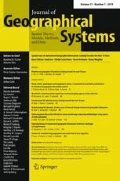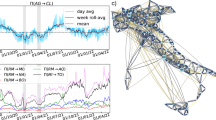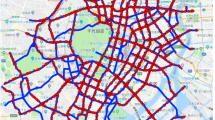Abstract
Detecting communities in large networks has become a common practice in socio-spatial analyses and has led to the development of numerous dedicated mathematical algorithms. Nowadays, however, researchers face a deluge of data and algorithms, and great care must be taken regarding methodological questions such as the values of the parameters and the geographical characteristics of the data. We aim here at testing the sensitivity of multi-scale modularity optimized by the Louvain method to the value of the resolution parameter (introduced by Reichardt and Bornholdt (Phys Rev Lett 93(21):218701, 2004. https://doi.org/10.1103/PhysRevLett.93.218701) and controlling the size of the communities) and to a number of spatial issues such as the inclusion of internal loops and the delineation of the study area. We compare the community structures with those found by another well-known community detection algorithm (Infomap), and we further interpret the final results in terms of urban geography. Sensitivity analyses are conducted for commuting movements in and around Brussels. Results reveal slight effects of spatial issues (inclusion of the internal loops, definition of the study area) on the partition into job basins, while the resolution parameter plays a major role in the final results and their interpretation in terms of urban geography. Community detection methods seem to reveal a surprisingly strong spatial effect of commuting patterns: Similar partitions are obtained with different methods. This paper highlights the advantages and sensitivities of the multi-scale Louvain method and more particularly of defining communities of places. Despite these sensitivities, the method proves to be a valuable tool for geographers and planners.












Similar content being viewed by others
Notes
For the sake of clarity, the term Louvain method used in this contribution refers to the multi-scale Louvain method.
Abbreviations
- Aud:
-
Auderghem
- And:
-
Anderlecht
- B:
-
City of Brussels (municipality)
- BCR:
-
Brussels Capital Region
- ET:
-
Etterbeek
- EVE:
-
Evere
- For:
-
Forest
- IX:
-
Ixelles
- Mol:
-
Molenbeek-Saint-Jean
- NMI :
-
Normalized mutual information
- Ottignies:
-
Ottignies Louvain-la-Neuve
- S:
-
Schaerbeeck
- SG:
-
Saint-Gilles
- SJ:
-
Saint-Josse-ten-Noode
- U:
-
Uccle
- VI:
-
Variation of information
- WL:
-
Woluwe-Saint-Lambert
- WP:
-
Woluwe-Saint-Pierre
- Z:
-
Zaventem
References
Anas A, Arnott R, Small K (1998) Urban spatial structure. J Econ Lit 36(3):1426–1464. http://econpapers.repec.org/article/aeajeclit/v_3a36_3ay_3a1998_3ai_3a3_3ap_3a1426-1464.htm
Arenas A, Fernández A, Gómez S (2008) Analysis of the structure of complex networks at different resolution levels. N J Phys 10(5):053039. http://stacks.iop.org/1367-2630/10/i=5/a=053039
Beguerisse-Díaz M, Garduño-Hernández G, Vangelov B, Yaliraki SN, Barahona M (2014) Interest communities and flow roles in directed networks: the Twitter network of the UK riots. J R Soc Interface 11(101):20140940. http://classic.rsif.royalsocietypublishing.org/content/11/101/20140940.short
Blondel V, Guillaume JL, Lambiotte R, Lefebvre E (2008) Fast unfolding of communities in large networks. J Stat Mech Theory Exp 10:P10008. https://doi.org/10.1088/1742-5468/2008/10/10008
Blondel V, Krings G, Thomas I (2010) Regions and borders of mobile telephony in Belgium and in the Brussels metropolitan zone. Brussels Stud 42(4):1–12. http://citeseerx.ist.psu.edu/viewdoc/download?doi=10.1.1.187.3791&rep=rep1&type=pdf
Census-2011 (2016) Census 2011. http://census2011.fgov.be/index_fr.html
Cerina F, Chessa A, Pammolli F, Riccaboni M (2014) Network communities within and across borders. Sci Rep 4:4546. https://doi.org/10.1038/srep04546
Cheshire P (2010) Why Brussels needs a City-Region for the City. Re-bel ebook 7 What does Geography teach us about the future of the Belgium’s Institution ? pp 33–48. http://www.rethinkingbelgium.eu/rebel-initiative-files/ebooks/ebook-7/Cheshire.pdf
Chi G, Thill JC, Tong D, Shi L, Liu Y (2016) Uncovering regional characteristics from mobile phone data: a network science approach. Pap Reg Sci 95(3):613–631. https://doi.org/10.1111/pirs.12149
Crampton JW, Graham M, Poorthuis A, Shelton T, Stephens M, Wilson MW, Zook M (2013) Beyond the geotag: situating ‘big data’ and leveraging the potential of the geoweb. Cartogr Geogr Inf Sci 40(2):130–139. https://doi.org/10.1080/15230406.2013.777137
Danon L, Diaz-Guilera A, Duch J, Arenas A (2005) Comparing community structure identification. J Stat Mech Theory Exp 2005(09):P09008.http://iopscience.iop.org/1742-5468/2005/09/P09008
Delmotte A, Tate EW, Yaliraki SN, Barahona M (2011) Protein multi-scale organization through graph partitioning and robustness analysis: application to the myosin–myosin light chain interaction. Phys Biol 8(5):055010. https://doi.org/10.1088/1478-3975/8/5/055010
Delvenne JC, Yaliraki SN, Barahona M (2010) Stability of graph communities across time scales. Proc Natl Acad Sci 107(29):12755–12760. https://doi.org/10.1073/pnas.0903215107
Delvenne JC, Schaub MT, Yaliraki SN, Barahona M (2013) The stability of a graph partition: a dynamics-based framework for community detection. In: Dynamics on and of complex networks, Volume 2, modeling and simulation in science, engineering and technology. Birkhäuser, New York, pp 221–242. https://doi.org/10.1007/978-1-4614-6729-8_11
Dujardin C, Thomas I, Tulkens H (2007) Quelles frontières pour Bruxelles? une mise à jour. Reflets et Perspectives de la vie économique XLVI(2–3):155–176. https://doi.org/10.3917/rpve.462.0155
Duranton G (2015) Delineating metropolitan areas: measuring spatial labour market networks through commuting patterns. In: Watanabe T, Uesugi I, Ono A (eds) The economics of interfirm networks, no. 4 in Advances in Japanese Business and Economics. Springer, Japan, pp 107–133. https://doi.org/10.1007/978-4-431-55390-8_6
Eggerickx T (2013) Transition démographique et banlieue en Belgique: le cas de Bruxelles. Ann de démogr Hist 126(2):51–80
Fischer MM, Essletzbichler J, Gassler H, Trichtl G (1993) Telephone communication patterns in Austria: a comparison of the IPFP-based graph-theoretic and the intramax approaches. Geogr Anal 25(3):224–233. https://doi.org/10.1111/j.1538-4632.1993.tb00293.x
Fortunato S (2009) Community detection in graphs. Phys Rep 486(3–5):75–174. https://doi.org/10.1016/j.physrep.2009.11.002
Fortunato S, Barthélemy M (2007) Resolution limit in community detection. Proc Natl Acad Sci 104(1):36–41. https://doi.org/10.1073/pnas.0605965104
Fortunato S, Lancichinetti A (2009) Community detection algorithms: a comparative analysis: invited presentation, extended abstract. In: Proceedings of the fourth international ICST conference on performance evaluation methodologies and tools, ICST (Institute for Computer Sciences, Social-Informatics and Telecommunications Engineering), p 27. http://dl.acm.org/citation.cfm?id=1698858
Freeman LC (1978) Centrality in social networks conceptual clarification. Soc Netw 1(3):215–239. https://doi.org/10.1016/0378-8733(78)90021-7
Fujita M, Thisse JF (2013) Economics of agglomeration: cities, industrial location, and globalization. Cambridge University Press, Cambridge
Géoconfluences (2017) Vocabulaire et notions générales. http://geoconfluences.ens-lyon.fr/glossaire. Accessed 30 Aug 2017
Grasland C (1999) Interaction spatiale et effets de barrière. 1 ère partie: des modèles d’interaction spatiale aux modèles d’interaction territoriale. Technical report, Miméo, CNRS-UMR Géographie-Cités
Haynes KE, Fotheringham AS (1984) Gravity and spatial interaction models, vol 2. Sage Publications, Beverly Hills. http://www.web.pdx.edu/~stipakb/download/PA557/ReadingsPA557sec1-2.pdf
Horner MW, Murray AT (2002) Excess commuting and the modifiable areal unit problem. Urban Stud 39(1):131–139. https://doi.org/10.1080/00420980220099113
INSEE (2015) Les zonages d’étude de l’Insee: une histoire des zonages supracommunaux définis à des fins statistiques. Insee méthode, p 97
Ioannides YM (2012) From neighborhoods to nations: the economics of social interactions. Economics Books, Princeton University Press. https://ideas.repec.org/b/pup/pbooks/9892.html
Jacobs J (1969) The economy of cities. Random House, New York
Jones J, Cloquet C, Adam A, Decuyper A, Thomas I (2016) Belgium through the lens of rail travel requests: does geography still matter? ISPRS Int J Geo-Inf 5(11):216. https://doi.org/10.3390/ijgi5110216
Jones J, Peeters D, Thomas I (2017) Scale effect in a LUTI model of Brussels: challenges for policy evaluation. EJTIR 17(1):103–131. http://www.tbm.tudelft.nl/fileadmin/Faculteit/TBM/Onderzoek/EJTIR/Back_issues/17.1/2017_01_05.pdf
Kitchin R, Tate N (1999) Conducting research in human geography: theory, methodology and practice, 1st edn. Longman, Harlow
Lambiotte R (2010) Multi-scale modularity in complex networks. In: 2010 Proceedings of the 8th international symposium on modeling and optimization in mobile, ad hoc and wireless networks (WiOpt), IEEE, pp 546–553. http://ieeexplore.ieee.org/xpls/abs_all.jsp?arnumber=5520347
Lambiotte R, Delvenne JC, Barahona M (2014) Random walks, Markov processes and the multiscale modular organization of complex networks. IEEE Trans Netw Sci Eng 1(2):76–90. https://doi.org/10.1109/TNSE.2015.2391998
Li X, Farber S (2016) Spatial representation in the social interaction potential metric: an analysis of scale and parameter sensitivity. J Geogr Syst 18(4):331–357. https://doi.org/10.1007/s10109-016-0238-6
Longley PA, Goodchild M, Maguire DJ, Rhind DW (2010) Geographic information systems and science. Wiley Publishing, New York
Montis AD, Caschili S, Chessa A (2013) Commuter networks and community detection: a method for planning sub regional areas. Eur Phys J Spec Top 215(1):75–91. https://doi.org/10.1140/epjst/e2013-01716-4
Newman MEJ, Girvan M (2004) Finding and evaluating community structure in networks. Phys Rev E 69(2):026113. https://doi.org/10.1103/PhysRevE.69.026113,
O’Kelly ME, Niedzielski MA, Gleeson J (2012) Spatial interaction models from Irish commuting data: variations in trip length by occupation and gender. J Geogr Syst 14(4):357–387. https://doi.org/10.1007/s10109-011-0159-3
Onnela JP, Arbesman S, González MC, Barabási AL, Christakis NA (2011) Geographic constraints on social network groups. PLoS ONE 6(4):e16,939. https://doi.org/10.1371/journal.pone.0016939
Papadopoulos S, Kompatsiaris Y, Vakali A, Spyridonos P (2011) Community detection in social media. Data Min Knowl Discov 24(3):515–554. https://doi.org/10.1007/s10618-011-0224-z
Poelmans L, Van Rompaey A (2009) Detecting and modelling spatial patterns of urban sprawl in highly fragmented areas: a case study in the Flanders-Brussels region. Landsc Urban Plan 93(1):10–19. https://doi.org/10.1016/j.landurbplan.2009.05.018
Ratti C, Sobolevsky S, Calabrese F, Andris C, Reades J, Martino M, Claxton R, Strogatz SH (2010) Redrawing the map of Great Britain from a network of human interactions. PLoS ONE 5(12):e14,248. https://doi.org/10.1371/journal.pone.0014248
Reichardt J, Bornholdt S (2004) Detecting fuzzy community structures in complex networks with a Potts model. Phys Rev Lett 93(21):218701. https://doi.org/10.1103/PhysRevLett.93.218701
Riguelle F, Thomas I, Verhetsel A (2007) Measuring urban polycentrism: a European case study and its implications. J Econ Geogr 7(2):193–215. https://doi.org/10.1093/jeg/lbl025
Rosvall M, Bergstrom CT (2008) Maps of random walks on complex networks reveal community structure. Proc Natl Acad Sci 105(4):1118–1123. http://www.pnas.org/content/105/4/1118.short
Scott AJ, Storper M (2015) The nature of cities: the scope and limits of urban theory. Int J Urban Reg Res 39(1):1–15. https://doi.org/10.1111/1468-2427.12134
Steinhaeuser K, Chawla NV (2010) Identifying and evaluating community structure in complex networks. Pattern Recogn Lett 31(5):413–421. https://doi.org/10.1016/j.patrec.2009.11.001
Strehl A, Ghosh J (2002) Cluster ensembles—a knowledge reuse framework for combining multiple partitions. J Mach Learn Res 3(Dec):583–617. http://www.jmlr.org/papers/v3/strehl02a.html
Thisse JF, Thomas I (2010) Bruxelles au sein de l’économie belge: un bilan. Regards écon (80). http://www.regards-economiques.be/index.php?option=com_reco&view=article&cid=91
Thomas I, Cotteels C, Jones J, Peeters D (2012) Revisiting the extension of the Brussels urban agglomeration: new methods, new data... new results? Belgeo Revue belge de géogr (1–2). http://belgeo.revues.org/6074
Van Hecke E, Halleux JM, Decroly JM, Merenne-Schoumaker B (2009) Noyaux d’habitat et Régions urbaines dans une Belgique urbanisée. Technical report, Direction générale Statistique et Information économique. http://orbi.ulg.be/handle/2268/66527
Vandermotten C, Leclercq E, Cassiers T, Wayens B (2009) L’économie bruxelloise. Brussels Studies, pp 1–13. http://www.lasso.be/sites/default/files/etatsgeneraux_note_economie_26-01-09.pdf
Verhetsel A, Thomas I, Beelen M (2010) Commuting in Belgian metropolitan areas. J Transp Land Use 2(3/4):109–131. http://citeseerx.ist.psu.edu/viewdoc/download?doi=10.1.1.232.9227&rep=rep1&type=pdf
Acknowledgements
This research was made possible with the support of Innoviris: project Anticipate—Prospective Research 88 BRU-NET. The authors warmly thank Christophe Cloquet for his precious and numerous advices.
Author information
Authors and Affiliations
Corresponding author
Appendix
Appendix
1.1 Extraction of the dominant community
With the multiple runs of the Louvain method, the nodes are characterized by a list of 1000 identification numbers (id) corresponding to the community number. It is important to underline that the allocation of nodes to communities is specific to each run of the Louvain method, implying that the ID of the communities is renumbered at each run. Hence, a community numbered “one” in the first run is not automatically labeled “one” in the other simulations; so we have to make the ID of the communities comparable through the runs of the Louvain method. The methodology is illustrated in Fig. 13.
First, each node is characterized by a list of 1000 elements corresponding to the communities where the nodes are allocated. We call this list the signature of the node and calculate the number of occurrences of each signature in the results. Second, the list of signatures is ordered by descending order of occurrence and we attribute to each specific id that we call the new community number. Third, the highly represented signature is used to renumber the communities detected. The renumbering starts with the nodes having the highest represented signature. The initial community numbers are modified with the new community number. Moreover, this renumbering is applied for the entire run and so, if the initial community number is still present, it is renumbered with the new community number too. This special case is illustrated in Fig. 13. In run 5, the nodes with the highest represented signature are nodes 1, 2, and 3 which belong to Community 1. In this run, we observe that a number of other nodes are initially classified within this community 1 (nodes 4 and 5). So, all these nodes (1, 2, 3, 4, and 5) are renumbered with the new community number 100. Once all the initial IDs of the communities have been modified by the new community number, the same procedure is applied to the second most frequent signature. This renumbering is applied until all the communities are renumbered. Finally, the dominant community (most frequent community) is extracted for each node and the stability of the nodes is calculated.
Rights and permissions
About this article
Cite this article
Adam, A., Delvenne, JC. & Thomas, I. Detecting communities with the multi-scale Louvain method: robustness test on the metropolitan area of Brussels. J Geogr Syst 20, 363–386 (2018). https://doi.org/10.1007/s10109-018-0279-0
Received:
Accepted:
Published:
Issue Date:
DOI: https://doi.org/10.1007/s10109-018-0279-0





